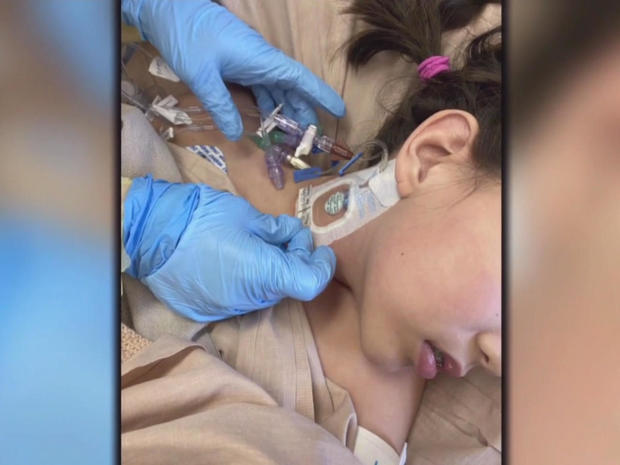What Kawasaki Disease can tell us about the new coronavirus-linked MIS-C illness in kids, and vice versa
[ad_1]
Tokyo — Doctors and scientists in the U.S. and Europe have called a mysterious new pediatric illness that appears linked to COVID-19 “deeply concerning.” Instead of attacking the lungs like the new coronavirus disease does in adults, this syndrome, while seemingly very rare, can trigger serious, even deadly cardiac complications in kids.
The emerging disorder, dubbed Multisystem Inflammatory Illness in Children, or MIS-C, presents some of the classic signs of a well-known disorder discovered more than half a century ago in Japan. The symptoms of MIS-C (sometimes referred to as PMIS) are so similar to Kawasaki Disease that doctors are debating whether there could be a connection.
Kawasaki Disease (KD) is a rare and seldom fatal non-contagious vascular illness primarily in children of Asian descent. It generally causes symptoms including a high fever, red eyes and rash. It can also trigger heart failure, but that complication is seen in very few Kawasaki sufferers.
Dr. Scott Gottlieb, former head of the Food and Drug Administration, told CBS’ “Face the Nation” on Sunday that MIS-C, “appears to be some kind of post-viral immune type phenomena associated with” COVID-19, though he stressed that any “causal relationship” remained unclear.
“We see this in other kinds of viruses,” Gottlieb said. “What we don’t know is the denominator.”
“Maybe it’s a totally different disease,” Dr. Mamoru Ayusawa, who’s devoted his career to diagnosing and studying Kawasaki Disease, told CBS News. He added, however, that COVID-19 could emerge as a new trigger for KD.
Similarities, and differences
While both KD and MIS-C both attack children, KD sufferers are overwhelmingly preschoolers and infants, while MIS-C strikes older children well into their teens.
CBS News senior medical correspondent Dr. Tara Narula notes that many of the treatments long used for KD patients have proven helpful and effective in treating children with MIS-C, including intravenous immunoglobulin (injecting antibodies from healthy blood plasma). Steroids, used for only the most serious KD cases, are also often prescribed for MIS-C.
Unaddressed, KD can lead to coronary damage, but with prompt treatment most patients go on to lead normal lives.
KD occurs worldwide and can leave patients with effects that last a lifetime. It’s the leading cause of acquired heart disease in the U.S. and Japan.
But for reasons still unknown, Japan is a KD hotspot. Japanese children suffer it at a rate of 359.1 per 100,000, by far the world’s highest, although other Asian countries including South Korea, China and Taiwan also report significant numbers of cases.
In the U.S., with a rate of about 20 per 100,000, the disease presents mostly among Asian-Americans. While extremely rare in Caucasians, Ayusawa said KD has been known to afflict blacks and Hispanics.
CBS News
That draws a stark differentiation with MIS-C: So far, not a single case of the new syndrome, seen mostly in Western Europe and the U.S., has been documented in the populations primarily affected by KD.
Ayusawa said none of the nearly 600 juveniles diagnosed with the new coronavirus disease in Japan have any history of KD, and of a sampling of the 134 KD patients seen so far this year, none have tested positive for the coronavirus that causes COVID-19.
“In Japan and neighboring countries at this time, no information strongly suggests a link between COVID-19 and KD,” the Japan Society for Kawasaki Disease said in a recent statement.
As Gottlieb said on Face the Nation, and as an Italian study has shown, coronavirus is strongly suspected of a link with MIS-C, however.
“Obviously there’s guilt by association,” Dr. Jane Burns, director of the Kawasaki Disease Research Center at UC San Diego, said in a recent video posted online. The new syndrome, she said, could even provide insights into KD.
“If COVID can be one of the triggers [of MIS-C], that’s going to teach us a lot about Kawasaki Disease and lead us to better understanding of how it can be so detrimental to the heart,” she said, adding that her hospital is seeing not just MIS-C patients, but a “remarkable rise” in Kawasaki Disease.
A familiar foe
It was Japanese physician Tomisaku Kawasaki who first observed the unusual disorder among his pediatric patients in the 1960s. He called it “acute febrile mucocutaneous lymph node syndrome,” but the illness came to bear his own name.
Ayusawa said KD is suspected when healthy children suddenly develop a fever and at least some of the other classic symptoms, such as rabbit-like pink or bloodshot eyes, red-rouge lips and strawberry-red tongue; swollen lymph nodes; rash or swollen hands and feet. Most improve after just a day or two of treatment.
The most recent annual survey by the Japan Kawasaki Disease Research Center, in 2018, showed that Japan logged 17,364 cases that year, a record high attributed to better surveillance and monitoring.
“We’ve aggressively moved to identify even mild cases,” Ayusawa said from his office at Tokyo’s Nihon University hospital, which has treated 2,500 of the total 395,238 KD patients seen in Japan as of 2018.
From a “double-digit” fatality rate in the early days, KD now is easily treatable, even at small hospitals throughout the country. Patients are concentrated among children 4 years of age or younger, disproportionately occurring in males about one year old.
While major strides have been made in diagnosing and treating KD over the last 60 years, doctors remain baffled by what causes it — just as they do with the new syndrome seen in the U.S. and Europe.
[ad_2]
Source link











